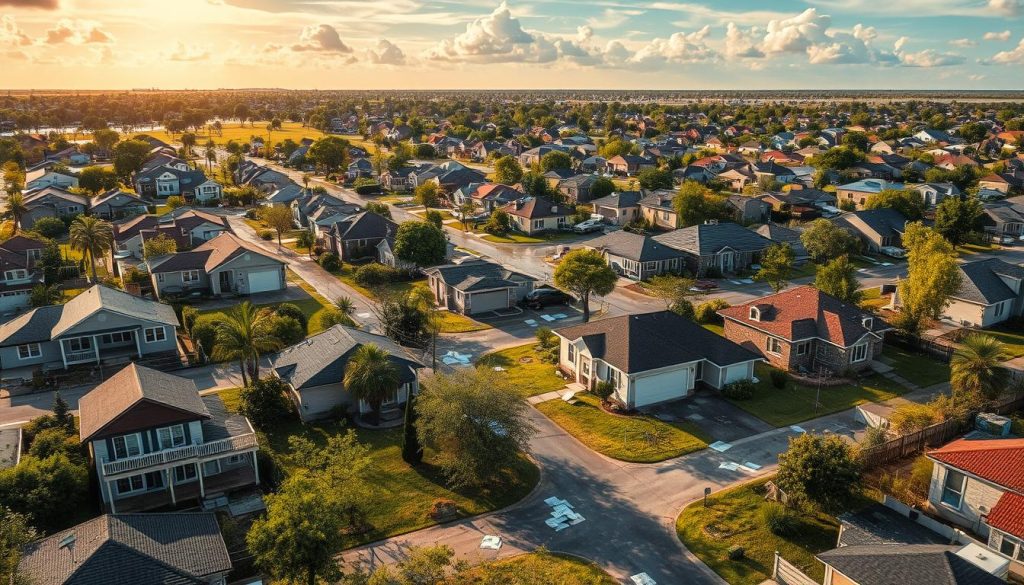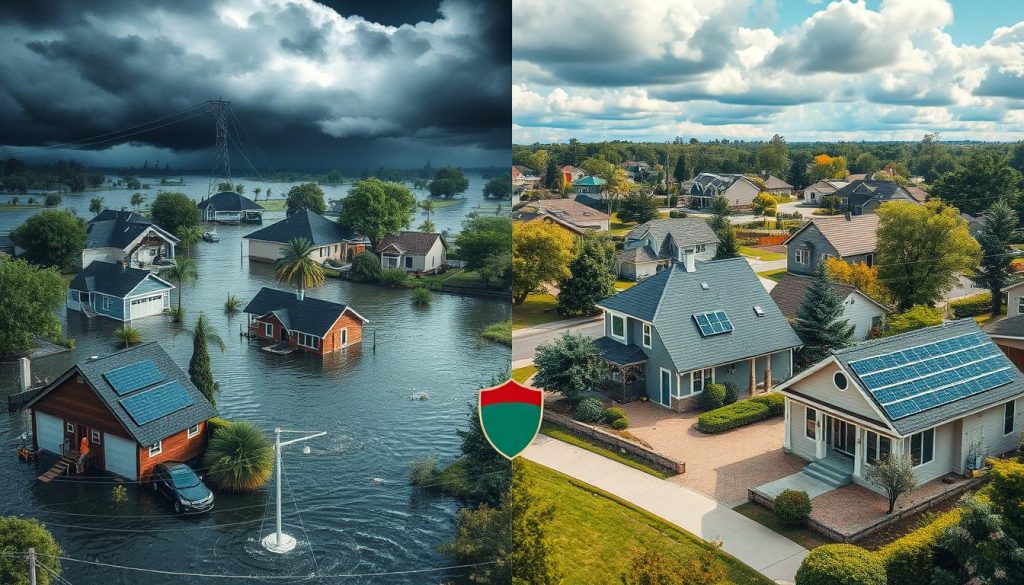The link between climate change and home insurance is getting more complicated. This is because climate-related disasters are happening more often and getting worse. Insurers are now looking at risks differently and changing their policies.
There’s been a big jump in extreme weather events. This has led to a lot more home insurance claims. Homeowners are facing more unpredictable natural disasters. It’s important to know how climate change affects home insurance.
In this article, we’ll look at how insurance costs are going up, the rise in climate-related claims, and how the insurance industry is dealing with these challenges.
Key Takeaways
- Climate change is reshaping home insurance policies across the nation.
- Rising extreme weather events lead to increased insurance claims.
- Understanding the risks associated with climate change is key for homeowners.
- Insurance costs vary by region due to different climate impacts.
- The insurance industry is adapting to changing climate risks.
Introduction to Climate Change and Insurance
Climate change is a big issue worldwide, affecting many areas, including insurance. The climate change impact on home insurance is huge. Rising sea levels, extreme weather, and changing temperatures bring new challenges for insurers. It’s important for both homeowners and insurance companies to understand these changes.
The insurance industry has always tried to keep up with environmental changes. But now, with more frequent and severe climate-related events, it’s more critical than ever. Insurers need to grasp the climate risks affecting home insurance coverage and climate change. They must look at climate models to predict big changes that will impact homes and properties.
Managing risks is key in the changing world of home insurance. Insurers need to update their policies to handle climate change’s uncertainties. Knowing how climate and insurance are connected helps homeowners protect their homes. It also lets insurers offer stronger, more reliable coverage.

The talk about climate change shows we need to act fast to reduce risks in home insurance. We must understand vulnerabilities, adjust coverage, and focus on thorough risk assessments. This is vital in today’s changing market.
The Impact of Climate Change on Home Insurance Policies
Natural disasters are happening more often and getting worse. This is because of climate change. Insurers are now facing more risks. They are changing how they offer coverage and set prices.
Insurers are using new methods to figure out risks. They look at climate data to set rates and decide what to cover. This means homeowners in risky areas might pay more for insurance.
Companies are making big changes in their policies. Some are not covering certain risks like flooding or wildfires in areas prone to them. This shows how important it is to keep up with changes in home insurance because of climate change.

Here’s a table showing how insurance costs might change in different areas because of climate risks:
| Region | Standard Premium (Before Adjustment) | Adjusted Premium (After Climate Assessment) | Percentage Increase |
|---|---|---|---|
| Southeast | $800 | $1,200 | 50% |
| California | $1,000 | $1,500 | 50% |
| Midwest | $600 | $800 | 33% |
| Northeast | $900 | $1,100 | 22% |
This data shows insurance costs are going up because of climate change. This can make it hard for homeowners to get the coverage they need.
Understanding Home Insurance Basics
Home insurance is key to protecting your home and stuff. It gives you financial safety against many risks. Knowing your policy well, even with climate change, is important. We’ll look at what home insurance covers and the kinds of policies out there.
What Does Home Insurance Cover?
Home insurance usually protects against:
- Structural Damage: It helps fix your home if it gets damaged by fire or storms.
- Personal Belongings: It covers your stuff inside the house, like furniture and gadgets.
- Theft: It pays out if your stuff gets stolen.
- Liability Protection: It keeps you safe from lawsuits if someone gets hurt at your place.
- Additional Living Expenses: It helps with living costs if you have to stay somewhere else while your home is fixed.
Types of Home Insurance Policies Available
It’s important to know the different home insurance policies. This helps you pick the right one, considering climate change risks:
| Policy Type | Description |
|---|---|
| Homeowners Insurance | Comprehensive coverage for both the structure and belongings. |
| Renters Insurance | Protects personal property in a rental unit, usually without covering the building. |
| Flood Insurance | Specialized coverage to protect against flood damage, often not included in standard policies. |
| Condo Insurance | Covers personal property and structural improvements in condominium units. |
| Earthquake Insurance | Protects against losses from earthquakes, typically requiring separate policies. |
Climate Change and Rising Insurance Costs
Climate change is making home insurance more expensive in many places. Insurers are dealing with more risks from natural disasters. This means they have to raise their rates. Knowing why insurance costs are going up and how it varies by location helps us understand this issue.
Factors Influencing Rising Premiums
Several things are making insurance more expensive because of climate change. These include:
- More frequent climate-related disasters.
- Higher costs to fix and rebuild after disasters like floods, hurricanes, and wildfires.
- New risk models that reflect changing weather patterns.
- Insurance companies need to stay profitable with more claims.
Regional Variations in Insurance Costs
Insurance prices change a lot depending on where you live. Places at risk for flooding or wildfires usually have higher rates. Here’s a table showing average home insurance costs in different states. It shows how climate change can make insurance costs very different:
| State | Average Annual Premium | Climate Risk Level |
|---|---|---|
| California | $1,015 | High (wildfires, earthquakes) |
| Florida | $1,853 | Very High (hurricanes, flooding) |
| Texas | $1,393 | High (hurricanes, tornadoes) |
| New York | $1,084 | Moderate (flooding, winter storms) |
| Ohio | $818 | Low (flooding, tornadoes) |
Climate-Related Claims in Home Insurance
Climate-related claims in home insurance are changing how policies work. As climate events grow more common, it’s key for homeowners and insurers to understand these claims. This helps them both adapt to the new world of home coverage.
Types of Climate-Related Claims
There are many types of claims from climate events. Some common ones include:
- Flood Damage: Damage from too much rain or rising water.
- Hurricane Damage: Damage to roofs, siding, and structures from strong winds and storms.
- Wildfire Damage: Losses from wildfires that threaten homes in risky areas.
- Storm Surge Damage: Damage from rising sea levels during severe storms.
- Freezing Pipe Claims: Water damage from pipes bursting in extreme cold.
Trends in Claims Due to Climate Events
Claims due to climate events have been going up a lot. This shows how climate change is affecting us. For example:
| Year | Flood Claims | Hurricane Claims | Wildfire Claims |
|---|---|---|---|
| 2015 | 25,000 | 15,000 | 10,000 |
| 2019 | 35,000 | 30,000 | 25,000 |
| 2023 | 50,000 | 45,000 | 40,000 |
The numbers show a clear rise in climate-related claims. This highlights the need for both homeowners and insurers to rethink their approaches.
Insurance Industry Response to Climate Change
The insurance industry is now focusing more on climate change. With more severe weather, insurers are changing how they work. They want to protect their clients better.
Insurers are using new tools to understand risks better. They look at how climate change affects areas. This helps them set the right prices for policies.
Many insurers also encourage clients to build sustainably. They suggest using energy-saving features and strong materials. This can lower risks and premiums for homeowners.
Big names like State Farm and Allstate are leading the way. They offer discounts for green practices and weather-proof homes. These steps show the industry is adapting to climate change.
The insurance industry is learning to adapt to climate change. By working together, they aim to make communities more resilient. Sustainable practices are key to the industry’s future.
| Company | Initiative | Focus Area |
|---|---|---|
| State Farm | Green Home Discounts | Sustainable Building |
| Allstate | Renewable Energy Rebates | Energy Efficiency |
| Progressive | Risk Assessment Tools | Climate Modeling |
| Liberty Mutual | Community Resilience Programs | Disaster Preparedness |
Climate Risk Assessment for Home Insurance
It’s important for homeowners and those looking to buy insurance to know how insurers assess climate risks. They use advanced models, data analytics, and predictive tools. This helps them offer the right coverage for climate-related risks.
How Insurers Assess Climate Risks
Insurers use different methods to check for climate-related dangers. They rely on risk modeling software to forecast events like floods and wildfires. By looking at past data and patterns, they can guess future risks in certain areas.
This approach helps them create policies that fit the unique challenges of different places.
The Role of Data in Risk Assessment
Data is key for assessing climate risks in home insurance. It includes things like where you live, past weather, and economic factors. By analyzing this data, insurers can spot and measure new risks.
This helps homeowners make better choices. Thanks to tech like big data analytics, the insurance world gets better at understanding climate threats. This makes risk assessments more accurate.
Adaptation Strategies for Home Insurance Under Climate Change
Climate change is affecting our homes, and we must take action. By using smart strategies, we can make our homes safer and maybe even save on insurance. Here are some important steps to take.
Home Improvements to Mitigate Risk
Renovating your home can make it stronger against weather dangers. Think about these upgrades:
- Roof Reinforcements: Choose materials that can handle strong winds.
- Flood Barriers: Put up barriers or fill areas to stop water from getting in.
- Energy-Efficient Windows: Get windows that are safe and save energy.
- Landscaping Adjustments: Use plants and design to stop soil erosion and control water flow.
Policy Adjustments and Coverage Enhancements
Insurance companies are now making policies better for climate change. Look into these options:
- Coverage for Natural Disasters: Make sure your policy covers damage from floods, storms, and wildfires.
- Discounts for Protective Upgrades: Ask about discounts for homes with safety features.
- Flexible Policy Revisions: Talk to your insurer about changing your coverage as risks change.
Case Studies: Climate Change Impact on Home Insurance Policies
Looking at real-life examples can help us understand climate change’s effects on home insurance. These stories show how communities deal with extreme weather and adjust their insurance plans.
Examples from High-Risk Areas
In places like Florida and California, hurricanes and wildfires are big worries. Insurers get a lot of claims. For example, a coastal town faced flooding many times.
Homeowners came together to buy flood barriers and better drainage. This move lowered their risk and led to cheaper insurance.
Success Stories in Adaptation
In the Midwest, where storms are common, people took action. They got grants to make their homes stronger, with better roofs and windows.
This effort cut down on storm damage claims. Insurers then offered better deals to homeowners. These stories show how smart planning can help with insurance.
| Area | Climate Event | Adaptation Strategy | Insurance Outcome |
|---|---|---|---|
| Florida | Hurricane | Flood barriers | Lower premiums due to reduced risk |
| California | Wildfire | Fire-resistant landscaping | Improved coverage options |
| Midwest | Severe storms | Storm-resistant retrofits | Fewer claims and better rates |
Future Outlook for Home Insurance in a Changing Climate
The future of home insurance looks different due to climate change. Insurers are changing their policies to deal with new risks. They’re also using new technologies to help.
Artificial Intelligence and machine learning are key in making policies better. These tools help insurers understand risks more clearly. This means homeowners get policies that really fit their needs.
There’s also a big push for sustainability in home insurance. Companies are giving discounts for eco-friendly homes. This helps homes be stronger and supports the environment.
- Increased integration of data analytics for risk assessment.
- Enhanced focus on resilience and adaptive strategies for homes.
- Collaboration with government agencies for better planning and support.
As the climate changes, home insurance must keep up. Insurers need to stay ahead, making policies for new risks. This way, they protect homeowners and stay financially stable in an uncertain future.
Mitigating Climate Risks in Home Insurance
Climate change is affecting our environment, and homeowners need to act. They must protect their homes and insurance. Homeowners and insurance agents must work together. This includes understanding options and following best practices.
Best Practices for Homeowners
Homeowners can take steps to reduce risks. These steps help protect homes and may lower insurance costs:
- Check your home for weaknesses against flooding, hurricanes, or wildfires.
- Use preventive measures like sump pumps, strong roofs, and fire-safe materials.
- Keep your home’s systems, like HVAC and plumbing, in good shape for climate events.
- Save records of any home improvements or repairs. This can help when talking to your insurer.
The Role of Insurance Agents in Risk Mitigation
Insurance agents are key in dealing with climate risks. They help homeowners choose the right policies. They also make sure homeowners understand their choices. It’s important to talk to your agent often to stay updated.
By following these steps and working with insurance agents, homeowners can better manage climate risks. This leads to a safer future for everyone.
Preparing for Climate Change Impacts on Home Insurance
Climate change is changing weather patterns and causing more natural disasters. Homeowners need to act now. Taking steps to prepare for climate change impacts on home insurance can help. This can reduce risks and protect your financial future. Here are some steps you can take to protect your home and improve your insurance policy.
Action Steps Homeowners Can Take
- Review Current Policies – Check what your insurance covers. Look for parts about natural disasters. Make sure it fits your needs.
- Invest in Climate-Resilient Features – Think about adding features that can handle extreme weather. This could be storm shutters or foundations that are higher up.
- Collaborate with Insurance Professionals – Talk to your insurance agent. They can help you see if your policy is right. They can also suggest changes that fit your risks.
- Stay Informed on Local Climate Risks – Watch local climate forecasts and trends. Knowing what’s happening in your area helps you make better choices for your home and insurance.
- Document Home Improvements – Keep a record of any upgrades or repairs. This is important when you talk about changing your policy or making a claim.
Conclusion
The impact of climate change on home insurance is deep and complex. It’s key for homeowners to understand how climate-related claims are changing. Insurers are now using climate risk assessments and updating their policies to handle more frequent and severe climate events.
Homeowners need to take steps to safeguard their homes. This could mean making improvements to reduce risk or updating their insurance to meet new needs. The insurance industry’s shift towards climate adaptation shows a big commitment to being ready and resilient. It’s vital to stay informed.
As climate change changes our environment, homeowners must stay alert and flexible. By linking climate change to home insurance, people can make smart choices. These choices protect their homes and help create a greener future.
FAQ
How is climate change impacting home insurance policies?
Climate change is making extreme weather events more common. This forces insurers to rethink their coverage and pricing. As a result, homeowners often see their premiums go up and their policies change.
What types of climate-related claims are most common?
Claims from floods, hurricanes, wildfires, and severe storms are most common. These claims are rising as climate events get more frequent and intense.
Why are insurance premiums rising due to climate change?
Insurance costs are going up because of more climate events. These events raise the risk for insurers. This means higher costs for them and, in turn, higher premiums for you.
What can homeowners do to prepare for climate change impacts on their insurance?
Homeowners can take steps to prepare. Review your policy, add climate-resilient features to your home, and talk to insurance experts. This helps tailor your coverage for climate risks.
How are insurers assessing climate risks?
Insurers use data analytics, predictive models, and geographic risk evaluations. They aim to understand how climate change affects their policyholders.
What are some adaptation strategies that can be employed under climate change?
Homeowners can adapt by retrofitting for floods, updating roofs for wind, and getting insurance that covers climate risks. These steps help protect your home.
What role do insurance agents play in mitigating climate risks?
Insurance agents are key in helping homeowners understand climate risks. They guide you through coverage options and advise on policy changes. This ensures you’re well-protected against climate impacts.
Can you provide examples of successful adaptation in high-risk areas?
Yes, some communities in high-risk areas have implemented building codes for resilience. These efforts lead to better insurance outcomes and lower claims rates over time.
Read Also: Telemedicine and Health Insurance: What You Need to Know





1 thought on “Climate Change Impacts on Home Insurance Policies”